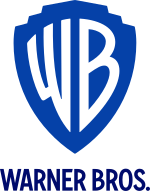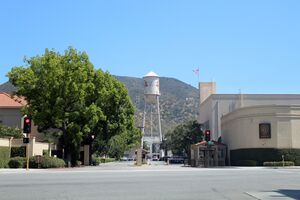وارنر برذرز
 Logo used since 2019 | |
 Warner Bros.' studio offices in Burbank, California | |
سابقاً |
|
|---|---|
| النوع | Subsidiary |
| الصناعة | Entertainment |
| السابق | Warner Features Company |
| تأسست | 4 أبريل 1923 |
| المؤسس | |
| المقر الرئيسي | 4000 Warner Blvd.، ، US |
| نطاق الخدمة | Worldwide |
الأشخاص الرئيسيون |
|
| المنتجات | |
| العلامات التجارية | |
| الدخل | |
| ربح العمليات | |
| الموظفون | قالب:Estimated 8,000 (2014) |
| الشركة الأم | Warner Bros. Discovery |
| الأقسام |
|
| الشركات التابعة | |
| الموقع الإلكتروني | warnerbros |
| Footnotes / references [1][2][3][4] | |
شركة وارنر برذرز الترفيهية المندمجة إنگليزية: Warner Bros. Entertainment, Incorporated ، أو وارنر برذرز إنگليزية: .Warner Bros أو Warner Brothers أو WB بإختصار ، شركة عملاقة لإنتاج الأفلام مقرها الرئيسي في ولاية كاليفورنيا ، أسسها أربعة اشقاء مهاجرين يهود من أصل بولندي في الرابع من أبريل عام 1923.
- هاري وارنر (1881 - 1958)
- البرت وارنر (1883 - 1967)
- سام وارنر (1887 - 1927)
- جاك وارنر (1892 - 1978)
ولعل من أبرز الأفلام التي قامت هذه الشركة العملاقة بإنتاجها أفلام : ماتريكس (Matrix) بأجزاءه الثلاث ، وسلسلة أفلام هاري بوتر (Harry Potter).
الإخوة وارنر Warner Bros شركة أمريكية تعد واحدة من أضخم الشركات المنتجة للأفلام السينمائية والمسلسلات التلفازية. وهي اليوم فرع لمجموعة شركات تايم وارنر Time Warner في كاليفورنيا.
التاريخ
التأسيس
استمدت الشركـة اسمها من الأشقاء الأربعة وارنـر Warnerـ المتحدرين من أصول بولونية ـ الذين أسسوها: هاري Harry ت(1881ـ1958)، ألبرت Albert ت(1883ـ1967)، سام Sam ت(1887ـ1927)، جاك Jack ت(1892ـ1978).
بدأ الإخوة العمل في السينما منذ عام 1903 حيث كانوا يعرضون الأفلام لعمال الجبال في بنسلفانيا Pennsylvania وأوهايو Ohio. وافتتحوا في العام نفسه في نيوكاسل New Castle أول صالة عرض سينمائي (كاسكاد) Cascade.
أسسوا في عام 1904 شركة Duquesne Amusement & Supply Company التي مارست توزيع الأفلام. وبعد بضع سنوات توسع مجال عمل الشركة حتى شمل أربع ولايات أمريكية.
بدأ الإخوة وارنر إنتاج أفلامهم الخاصة في بداية الحرب العالمية الأولى، وفي عام 1918 افتتحوا في هوليوود Hollywood «استوديو» خاصاً بهم Warner Bros. Studio. وقد اختص الأخوان سام وجاك بإنتاج الأفلام في حين اختص الأخوان الآخران هاري وألبرت بمسائل التمويل والتوزيع في نيويورك.
ازدهرت أحوال الشركة مما سمح للإخوة وارنر في عام 1924 أن يتلقوا قروضاً من مصارف وول ستريت Wall Street. فاشتروا بهذه القروض شركة فيتاغراف Vitagraph Company التي تملك شبكة توزيع واسعة، ومحطات إذاعية عدة وبنوا صالات عرض جديدة.
بدأت شركة الإخوة وارنر منذ منتصف العشرينيات تعمل على تطوير الصوت في السينما، وفي عام 1926 بدأت بإنتاج أفلام ذات مقاطع موسيقية ومؤثرات صوتية. وفي عام 1927 تم إنتاج فيلم «مغني الجاز» Jazz Singer الناطق الذي أثار ضجة لدى عرضه، واضعاً بداية عصر السينما الناطقة.
اشترت شركة وارنر عام 1928 واحدة من أوسع شبكات الصالات السينمائية، وهي شركة ستانلي Stanley Company. وفي عام 1929 اشترت أيضاً الشركة المنافسة الرئيسة لها الأولى للأفلام الوطنية First National Pictures.
أنتج الإخوة وارنر عام 1928 فيلم «أضواء نيويورك» Lights of New York ذا الشريط الصوتي المتطور، ومنذ عرضه تحولت الصناعة السينمائية برمتها إلى السينما الناطقة. وفي عام 1929 أنتج الإخوة وارنر فيلم «مع العرض» On with the Show الذي يعد أول فيلم ملون بالكامل. ثم أنتجت الفيلم الملون التالي «حفارات برودواي الذهبية» Gold Diggers of Broadway الذي حاز شهرة كبيرة لدرجة أن عرضه استمر سنوات عدة، وكان فاتحة عهد السينما الملونة.
أنتج الإخوة وارنر في الفترة ما بين 1929ـ1931 كثيراً من الأفلام الملونة، وكانت في معظمها أفلاماً غنائية، مما جعل المشاهدين ينصرفون عنها في النهاية، فاضطرت الشركة إلى إيقاف هذا النوع من الأفلام.
اشتهرت الشركة في الثلاثينيات بأفلام العصابات gangsters والأفلام الميلودرامية التي أنتجتها. وتعرضت عام 1934 لمشكلات مع الرقابة فتحولت إلى إنتاج الأفلام التاريخية. وفي الثلاثينيات أيضاً أسست شركة مستقلة لإنتاج أفلام الرسوم المتحركة حملت اسم Warner’s cartoon.
ازدهرت في أثناء الحرب العالمية الثانية أحوال الإخوة وارنر بسبب الطلب المتزايد على الأفلام السينمائية. وفي عام 1948 تعرضت الشركة للمحاكمة بتهمة الاحتكار، وصدر الحكم عليها وعلى أربع من أكبر الشركات السينمائية بوجوب فصل الإنتاج عن شبكات صالات العرض السينمائي التابعة لها.
وجد الإخوة وارنر أن إنتاج الأفلام من دون امتلاك شبكات عرض واسعة ليس مجدياً من الناحية الاقتصادية، مما حداهم في النهاية على بيع الشركة لأحد الاتحادات المصرفية. واكتشف الأخوان هاري وألبرت عام 1956 أن شقيقهم الثالث جاك كان المستثمر الرئيسي في هذا الاتحاد المصرفي. عند ذاك افترق الإخوة إلى غير رجعة. وقد حمل جاك مسؤولية الشركة على عاتقه.
عملت الشركة بعض الوقت في اقتباس المسرحيات الرائجة، وحققت نجاحاً في إنتاج المسلسلات التلفازية. وافتتحت عام 1958 شركة جديدة تابعة لها اختصت بالتسجيلات الصوتية: Warner Bros. Records، بعد أن وجدت أن ريع الأفلام في تلك المرحلة كان يتراجع.
باع جاك وارنر الشركة عام 1967 إلى الشركة الكندية الفنون السبعة للإنتاج Seven Arts Productions. فتغير اسم الشركة ليصير Warner Bros.-Seven Arts.
بعد عامين من ذلك التاريخ بيعت الشركة مجدداً لشركة Kinney National Company، فصار اسمها Warner Bros. Pictures.
كانت أعوام السبعينيات والثمانينيات من القرن العشرين سيئة لجميع الشركات السينمائية، ولكن إدارة «استوديو» وارنر الجديدة استطاعت تخطي الصعوبات حين راهنت على استغلال كبار الممثلين في الأفلام المنتجة من قبلها، مثل: بول نيومان Paul Newman، روبرت ردفورد Robert Redford، باربارة سترايساند Barbra Streisand، جون واين John Wayne، كلينت إيستوود Clint Eastwood، وغيرهم.
في عام 1976 تغير اسمها وصار Warner Communications، ثم اتحدت عام 1989 مع شركة Time, Inc. ليصير اسمها Time Warner.
اتجهت الشركة عام 1995 إلى جمهور المراهقين وأطلقت شبكتها التلفازية: WB Network، التي راحت تعرض أكثر المسلسلات رواجاً: «السماء السابعة» z7th Heaven، و«المسحور» Charmed وغيرهما. وفي عام 2006 وبالاتفاق مع شركة CBS اتخذت شركة وارنر قراراً بإغلاق شبكتها التلفازية وتأسيس شبكة أخرى جديدة تحت اسم CW Television Network.
Company units
Warner Bros. Entertainment operates three primary business segments they call "divisions": Motion Picture Group, Television, and other entertainment assets (which includes Digital Networks, Technology, Live Theatre, and Studio Facilities).
Motion Pictures includes the company's primary business units, such as Warner Bros. Pictures, New Line Cinema, DC Studios and Castle Rock Entertainment.
| Motion Picture Group | Television Group | Entertainment |
|---|---|---|
|
Executive management
- Chairman of the board
- Robert A. Daly (1980–1999)
- Barry Meyer (1999–2013)
- Kevin Tsujihara (2013–2019)
- Ann Sarnoff (2019–2022)
- Vice chairman
- Edward A. Romano (1994–2016)
- Presidents
- Terry Semel (1994–1999)
- Chief executive officers
- Robert A. Daly (1980–1999)
- Barry Meyer (1999–2013)
- Kevin Tsujihara (2013–2019)
- Ann Sarnoff (2019–2022)
- Chief operating officers
- Terry Semel (1982–1994)
- Barry Meyer (1994–1999)
International distribution arrangements
From 1971 until the end of 1987, Warner's international distribution operations were a joint venture with Columbia Pictures. In some countries, this joint venture distributed films from other companies (such as EMI Films and Cannon Films in the UK). Warner ended the venture in 1988.
On May 4, 1987, Buena Vista Pictures Distribution signed a theatrical distribution agreement with Warner Bros. International for the release of Disney, Touchstone and Hollywood Pictures films in overseas markets, with Disney retaining full control of all distribution and marketing decisions on their product.[5] In 1992, Disney opted to end their joint venture with Warner Bros. to start autonomously distributing their films in the aforementioned markets.
On February 6, 2014, Columbia TriStar Warner Filmes de Portugal Ltda., a joint venture with Sony Pictures which distributed both companies' films in Portugal, announced that it would close its doors on March 31, 2014.[6] NOS Audiovisuais handles distribution of Warner Bros. films in Portugal since then, while the distribution duties for Sony Pictures films in the country were taken over by Big Picture Films.
Warner Bros. still handles the distribution of Sony Pictures films in Italy.
Since January 1, 2021, Warner Bros. films are distributed through Universal Pictures in Hong Kong citing WarnerMedia's closure of its Hong Kong theatrical office.[7] On January 12, 2021, Warner Bros. handles the theatrical distribution of Universal Pictures films in Brazil.[8]
In August 2022, Warner Bros. Pictures entered into a multi-year deal for distributing MGM films outside the United States, including on home entertainment. The contract included joint participation of both companies for marketing, advertising, publicity, film distribution, and relationship with exhibitors for future MGM titles.[9]
Film library
Acquired libraries
Mergers and acquisitions have helped Warner Bros. accumulate a diverse collection of films, cartoons and television programs. As of 2022, Warner Bros. owned more than 145,000 hours of programming, including 12,500 feature films and 2,400 television programs comprising more than tens of thousands of individual episodes.[10]
In the aftermath of the 1948 antitrust suit, uncertain times led Warner Bros. in 1956 to sell most of its pre-1950[11][12][13][14] films and cartoons to Associated Artists Productions (a.a.p.). In addition, a.a.p. also obtained the Fleischer Studios and Famous Studios Popeye cartoons, originally from Paramount Pictures. Two years later, a.a.p. was sold to United Artists, which owned the company until 1981, when Metro-Goldwyn-Mayer acquired United Artists.[15][16]
In 1982, during their independent years, Turner Broadcasting System acquired Brut Productions, the film production arm of France-based then-struggling personal-care company Faberge Inc.[17]
In 1986, Turner Broadcasting System acquired Metro-Goldwyn-Mayer. Finding itself in debt, Turner Entertainment kept the pre-May 1986 MGM film and television libraries and a small portion of the United Artists library (including the a.a.p. library and North American rights to the RKO Radio Pictures library) while spinning off the rest of MGM.[18]
In 1989, Warner Communications acquired Lorimar-Telepictures Corporation.[19][20] Lorimar's catalogue included the post-1974 library of Rankin/Bass Productions, and the post-1947 library of Monogram Pictures/Allied Artists Pictures Corporation.
In 1991, Turner Broadcasting System acquired animation studio Hanna-Barbera and the Ruby-Spears library from Great American Broadcasting, and years later, Turner Broadcasting System acquired Castle Rock Entertainment on December 22, 1993,[21][22] and New Line Cinema on January 28, 1994.[23][24] On October 10, 1996, Time Warner acquired Turner Broadcasting System, thus bringing Warner Bros.' pre-1950 library back home. However, Warner Bros. only owns Castle Rock Entertainment's post-1994 library. In 2008, Time Warner integrated New Line into Warner Bros.
The Warner Bros. Archives
The University of Southern California Warner Bros. Archives is the largest single studio collection in the world. Donated in 1977 to USC's School of Cinema-Television by Warner Communications, the WBA houses departmental records that detail Warner Bros. activities from the studio's first major feature, My Four Years in Germany (1918), to its sale to Seven Arts in 1968. It presents a complete view of the production process during the Golden Age of Hollywood. UA donated pre-1950 Warner Bros. nitrate negatives to the Library of Congress and post-1951 negatives to the UCLA Film and Television Archive. Most of the company's legal files, scripts, and production materials were donated to the Wisconsin Center for Film and Theater Research.
See also
- Warner Bros. Studios, Burbank
- Warner Bros. Studio Tour Hollywood
- Warner Bros. Home Entertainment
- Warner Bros. Family Entertainment
- Warner Bros. Television Studios
- Warner Bros. Discovery Global Brands and Experiences
- Warner Records
- List of Warner Bros. short subjects
- Warner Bros. Animation
- Warner Bros. Studios, Leavesden
Notes
References
Footnotes
- ^ "2020 Financial and Operational Trends" (PDF). AT&T. January 27, 2021. Archived (PDF) from the original on November 11, 2021. Retrieved April 27, 2022.
- ^ "Company history". Warner Bros. Archived from the original on October 16, 2015. Retrieved April 9, 2014.
- ^ Patten, Dominic; Yamato, Jen. "Warner Bros Layoffs Long Planned But "Accelerated" By Failed Fox Bid". Deadline Hollywood. Archived from the original on September 6, 2014. Retrieved September 6, 2014.
- ^ "Warner Archive Collection podcast". Warnerbros.com. April 8, 2014. Archived from the original on March 4, 2016. Retrieved December 17, 2016.
- ^ "Warner Bros. and Disney have a distribution pact". Los Angeles Times. May 4, 1987. Archived from the original on January 29, 2018. Retrieved January 17, 2018.
- ^ de Barros, Eurico (February 6, 2014). "Columbia Tristar Warner encerra escritórios em Portugal" [Columbia Tristar Warner closes offices in Portugal]. Diário de Notícias (in البرتغالية). Archived from the original on September 30, 2017. Retrieved September 29, 2017.
- ^ "WarnerMedia Closing Hong Kong Theatrical Division; Universal To Release WB Pictures In Market" (Press release). Deadline. December 24, 2020. Retrieved December 22, 2022.
- ^ "Portal Exibidor - CADE autoriza acordo entre Universal e Warner; saiba mais!". www.exibidor.com.br (in البرتغالية). Archived from the original on June 18, 2022. Retrieved 2022-05-19.
- ^ D'Alessandro, Anthony (2022-08-14). "Warner Bros Forms Multi-Year Pact To Distribute MGM Movies Overseas Beginning With 'Bones And All', 'Creed III'; How Bond Will Be Handled". Deadline (in الإنجليزية الأمريكية). Archived from the original on August 15, 2022. Retrieved 2022-10-04.
- ^ "Warner Bros. Unveils Centennial Logo in Advance of the Iconic Studio's 100th Anniversary" (Press release). Warner Bros. March 23, 2022. Retrieved September 12, 2022.
- ^ "Warner Films Bought for $21 Million; Largest Library Yet for Television" (PDF). Broadcasting. March 5, 1956. p. 42.
- ^ خطأ استشهاد: وسم
<ref>غير صحيح؛ لا نص تم توفيره للمراجع المسماةymrt - ^ خطأ استشهاد: وسم
<ref>غير صحيح؛ لا نص تم توفيره للمراجع المسماةaap exceptions - ^ خطأ استشهاد: وسم
<ref>غير صحيح؛ لا نص تم توفيره للمراجع المسماةarchive.org - ^ Hoyt, Eric (July 3, 2014). Hollywood Vault: Film Libraries Before Home Video. Univ of California Press. ISBN 978-0-520-95857-9 – via Google Books.
- ^ Cole, Robert J. (May 16, 1981). "M-G-M Is Reported Purchasing United Artists for $350 million". The New York Times. ISSN 0362-4331. Archived from the original on September 8, 2016. Retrieved October 26, 2016.
- ^ "Faberge Sells Brut's Assets". The New York Times. January 1982. Archived from the original on July 1, 2017. Retrieved November 27, 2014.
- ^ "Turner Sells Fabled MGM but Keeps a Lion's Share". Los Angeles Times. December 20, 1985. Archived from the original on August 1, 2017. Retrieved February 2, 2018.
- ^ "Crash Landing Merv Adelson—TV mogul, multimillionaire, and friend of the famous—lived a show-business fantasy. His bankruptcy has shocked Hollywood. – November 10, 2003". CNN. Archived from the original on January 26, 2013. Retrieved September 2, 2015.
- ^ "Warner Completes Merger With Lorimar Telepictures". Los Angeles Times. Archived from the original on November 3, 2012. Retrieved October 23, 2010.
- ^ "Turner Broadcasting Company Report". sec.gov. Securities and Exchange Commission. Archived from the original on July 10, 2017. Retrieved November 8, 2017.
- ^ "Done deal: Turner Broadcasting System Inc. said it closed..." Chicage Tribune. Archived from the original on March 2, 2016. Retrieved September 2, 2015.
- ^ "New Line to Join Ted Turner Empire Today : Film: With more money, the company is likely to add a few big movies to its annual production schedule". Los Angeles Times. January 28, 1994. Archived from the original on March 25, 2019. Retrieved October 30, 2019.
- ^ "New Line Cinema". ethicalbusinessbureau.com. Archived from the original on March 2, 2016. Retrieved October 30, 2019.
مصادر
- محمود عبد الواحد
للاستزادة
- جورج سادول، تاريخ السينما في العالم، ترجمة: إبراهيم الكيلاني ـ فايز كم نقش (منشورات عويدات، لبنان 1968).
- سمير فريد، مخرجون واتجاهات في السينما الأمريكية (منشورات وزارة الثقافة ـ المؤسسة العامة للسينما، دمشق 2001).
- إدوارد كامبيل، هوليوود وأسطورة الجنوب الأمريكي، ترجمة: زياد ينم (منشورات وزارة الثقافة ـ المؤسسة العامة للسينما، دمشق 2003).
External links
قالب:Warner Bros. Discovery قالب:Warner Bros. franchises قالب:Film studios قالب:Academy Award Best Picture Producers
- CS1 البرتغالية-language sources (pt)
- CS1 الإنجليزية الأمريكية-language sources (en-us)
- Short description is different from Wikidata
- Articles containing إنگليزية-language text
- Pages using Lang-xx templates
- Official website different in Wikidata and Wikipedia
- Warner Bros.
- 1923 establishments in California
- American companies established in 1923
- American corporate subsidiaries
- Film studios in Southern California
- Companies based in Burbank, California
- Entertainment companies based in California
- Entertainment companies established in 1923
- Film distributors of the United States
- Film production companies of the United States
- Film studios
- Mass media companies established in 1923
- Organizations awarded an Academy Honorary Award
- San Fernando Valley
- Sibling filmmakers
- Warner Bros. Discovery subsidiaries
- Major film studios
- شركات ترفيه
- شركات أمريكية
- إستوديوهات أفلام

